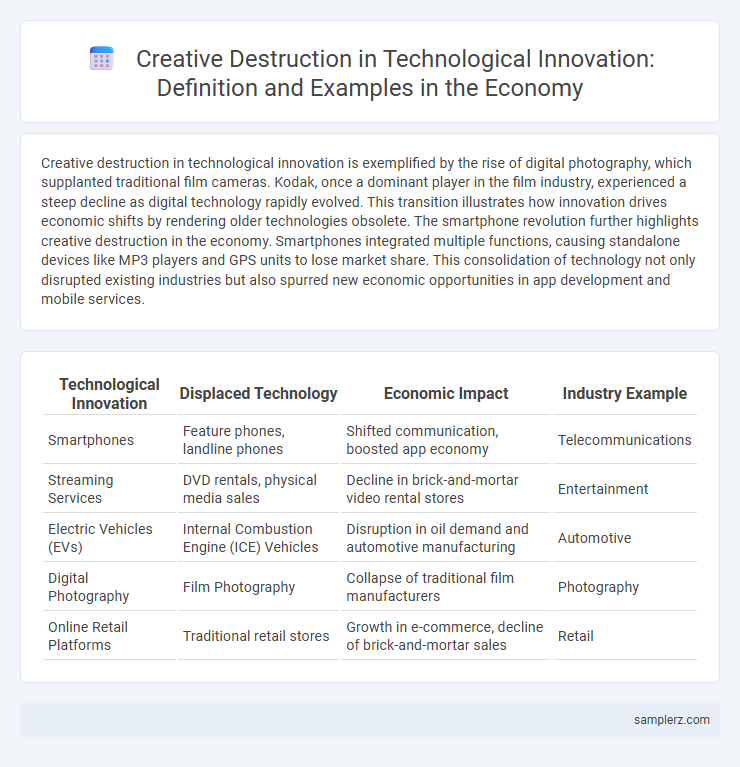Creative destruction in technological innovation is exemplified by the rise of digital photography, which supplanted traditional film cameras. Kodak, once a dominant player in the film industry, experienced a steep decline as digital technology rapidly evolved. This transition illustrates how innovation drives economic shifts by rendering older technologies obsolete. The smartphone revolution further highlights creative destruction in the economy. Smartphones integrated multiple functions, causing standalone devices like MP3 players and GPS units to lose market share. This consolidation of technology not only disrupted existing industries but also spurred new economic opportunities in app development and mobile services.
Table of Comparison
| Technological Innovation | Displaced Technology | Economic Impact | Industry Example |
|---|---|---|---|
| Smartphones | Feature phones, landline phones | Shifted communication, boosted app economy | Telecommunications |
| Streaming Services | DVD rentals, physical media sales | Decline in brick-and-mortar video rental stores | Entertainment |
| Electric Vehicles (EVs) | Internal Combustion Engine (ICE) Vehicles | Disruption in oil demand and automotive manufacturing | Automotive |
| Digital Photography | Film Photography | Collapse of traditional film manufacturers | Photography |
| Online Retail Platforms | Traditional retail stores | Growth in e-commerce, decline of brick-and-mortar sales | Retail |
Iconic Examples of Creative Destruction in Tech History
The rise of smartphones exemplifies creative destruction by rendering traditional landline phones and standalone devices like MP3 players obsolete, revolutionizing communication and media consumption worldwide. The shift from film to digital photography disrupted established industries such as Kodak, demonstrating how technological innovation can dismantle long-standing market leaders. Similarly, the transition from physical retail to e-commerce giants like Amazon has transformed consumer behavior and retail infrastructures, highlighting the economic impact of creative destruction in the technology sector.
How Smartphones Replaced Traditional Mobile Phones
Smartphones revolutionized communication by integrating multiple functions such as internet access, cameras, and apps, rendering traditional mobile phones obsolete. The rapid adoption of smartphones disrupted manufacturers focusing solely on basic mobile devices, forcing a shift toward advanced technology and software ecosystems. This transition exemplifies creative destruction, where innovation drives economic growth by replacing outdated products with more versatile and efficient alternatives.
Streaming Services and the Demise of Physical Media
The rise of streaming services such as Netflix and Spotify exemplifies creative destruction by revolutionizing media consumption and driving the decline of physical media like DVDs and CDs. This technological innovation disrupted traditional distribution channels, leading to significant shifts in revenue models and consumer behavior within the entertainment industry. The economic impact includes reduced manufacturing and retail costs, while enabling scalable, on-demand access to vast content libraries.
E-Commerce Platforms Disrupting Brick-and-Mortar Retail
E-commerce platforms like Amazon and Alibaba have revolutionized retail by offering vast product selections and convenient online shopping experiences, leading to the decline of traditional brick-and-mortar stores. This digital transformation exemplifies creative destruction, where innovative technologies disrupt established business models and consumer behaviors. The shift toward online marketplaces has driven retail efficiency, reduced operational costs, and reshaped global supply chains.
Electric Vehicles Accelerating the Decline of Combustion Engines
The rapid advancement of electric vehicles (EVs) is accelerating the decline of internal combustion engines by disrupting traditional automotive manufacturing and fueling investment in battery technologies. Tesla's innovation in long-range batteries and autonomous driving capabilities has driven legacy automakers like Ford and General Motors to pivot toward electrification, reducing reliance on fossil fuel-powered engines. This shift exemplifies creative destruction, where emerging green technologies systematically replace outdated combustion engine platforms, reshaping global transportation and energy markets.
Ride-Sharing Apps Revolutionizing Urban Transportation
Ride-sharing apps like Uber and Lyft exemplify creative destruction by disrupting traditional taxi services and urban transportation models. These platforms leverage smartphone technology and real-time data to offer more efficient, cost-effective, and flexible mobility options for millions of city dwellers worldwide. The disruption spurred advancements in digital payment systems, GPS navigation, and on-demand service economies, fundamentally reshaping urban transit ecosystems and regulatory frameworks.
Digital Photography Ousting Film Cameras
Digital photography revolutionized the imaging industry by rendering traditional film cameras obsolete, exemplifying creative destruction in technological innovation. The rapid adoption of digital sensors and image processing technology enabled instant image capture, editing, and sharing, drastically reducing the demand for film and development services. This transition redefined market dynamics and spurred growth in new digital platforms and camera manufacturers.
Online News Portals Replacing Print Newspapers
The rise of online news portals has revolutionized the media landscape by rapidly replacing traditional print newspapers, reflecting a clear example of creative destruction. Innovations such as real-time news updates, personalized content algorithms, and multimedia integration have made digital platforms more accessible and engaging for consumers. This shift drives economic transformation by reallocating resources from costly print infrastructure to dynamic, technology-driven news dissemination.
Cloud Computing Shifting Away from On-Premises IT Infrastructure
Cloud computing exemplifies creative destruction by rapidly replacing traditional on-premises IT infrastructure, enabling businesses to reduce capital expenses and scale resources dynamically. Leading providers like Amazon Web Services, Microsoft Azure, and Google Cloud have disrupted legacy hardware markets by offering flexible, pay-as-you-go models and global data center networks. This shift accelerates digital transformation, driving efficiency and innovation across industries while rendering outdated IT investments obsolete.
Fintech Startups Challenging Traditional Banking Models
Fintech startups are revolutionizing financial services by leveraging blockchain technology, artificial intelligence, and mobile platforms to offer faster, more accessible, and cost-effective banking solutions. These innovations disrupt traditional banking models by reducing reliance on brick-and-mortar branches and streamlining credit scoring through big data analytics. As a result, they catalyze creative destruction by forcing incumbent banks to adapt or exit the market, accelerating the evolution of the financial ecosystem.

example of creative destruction in technological innovation Infographic
 samplerz.com
samplerz.com